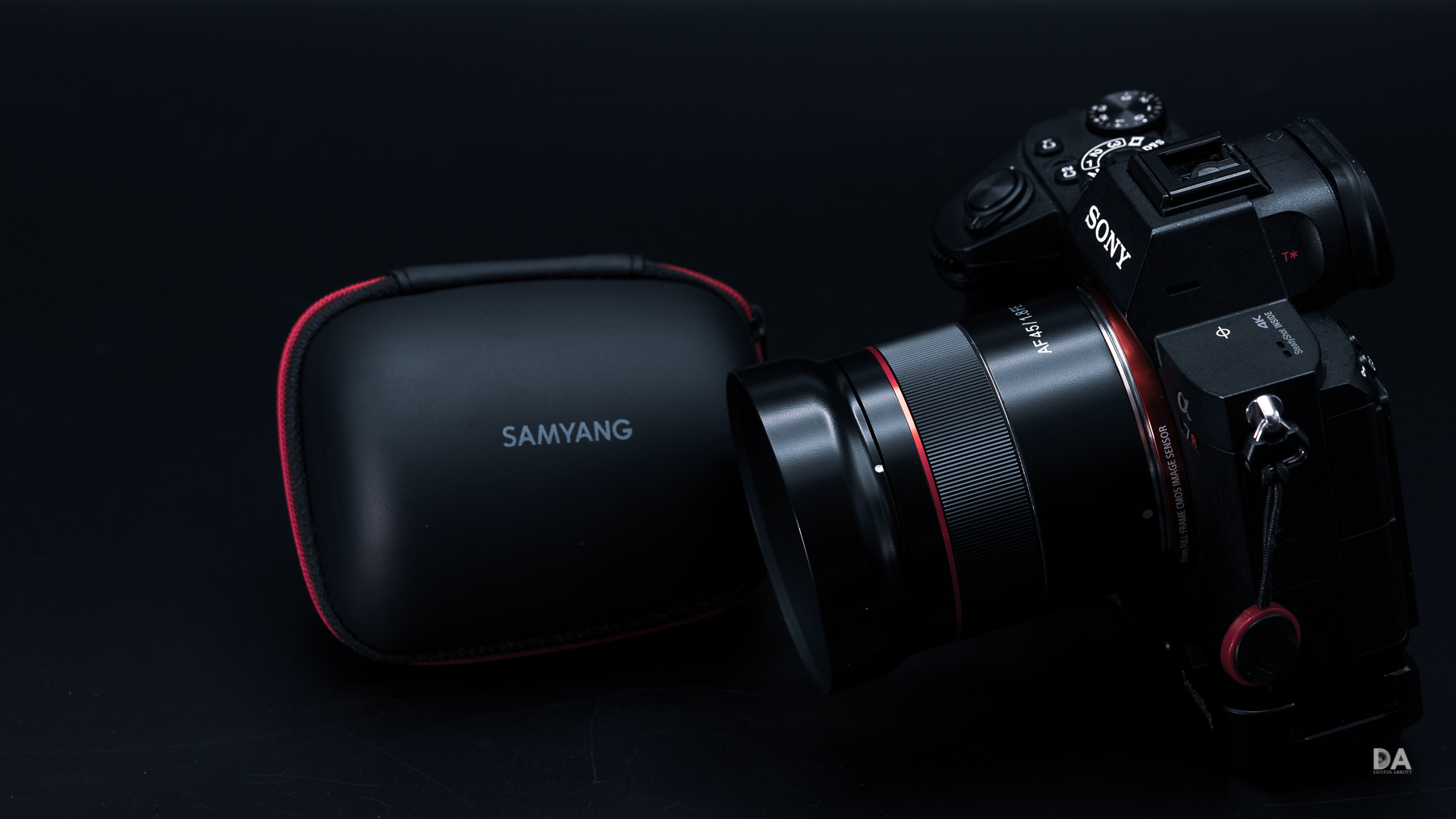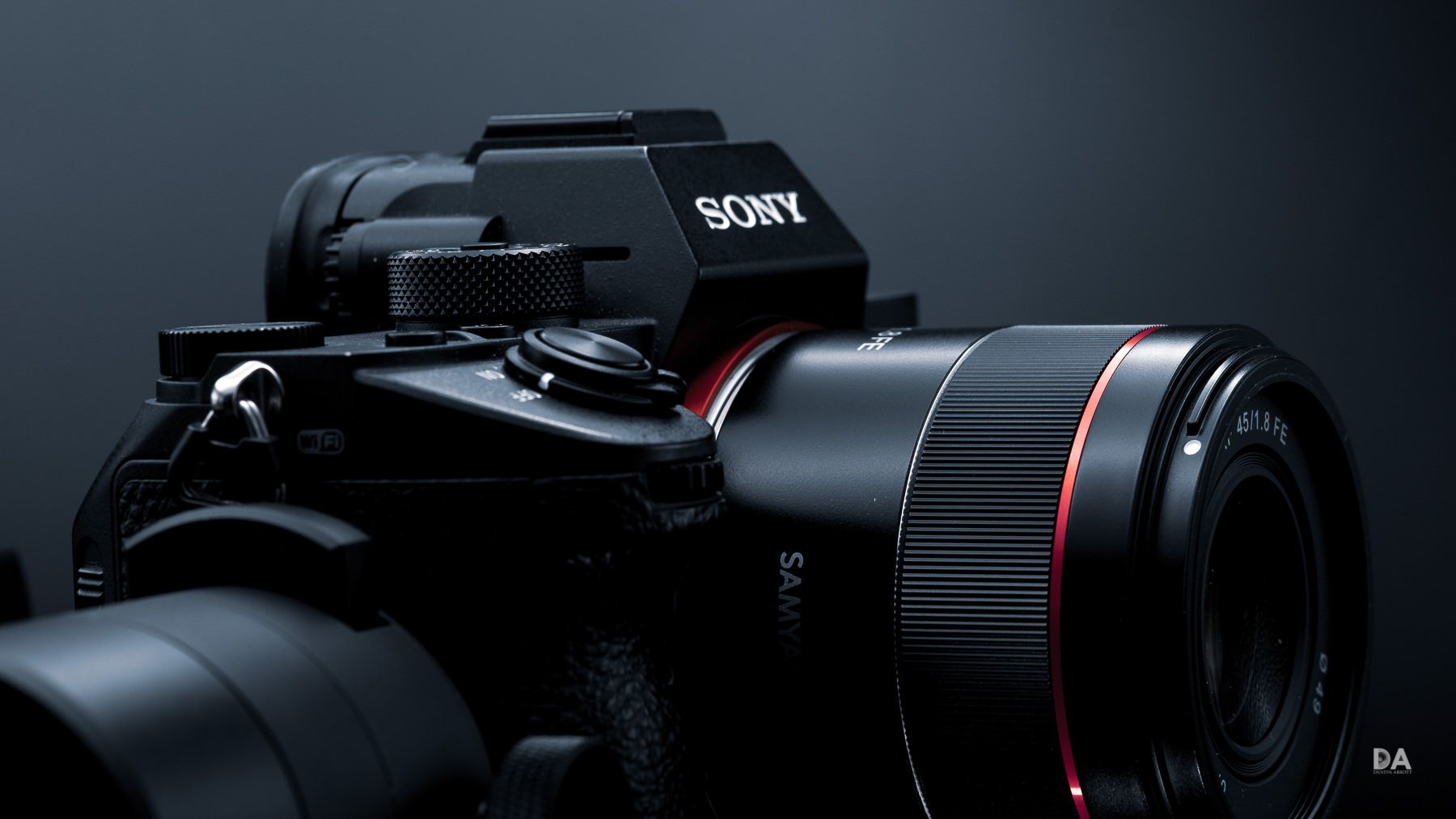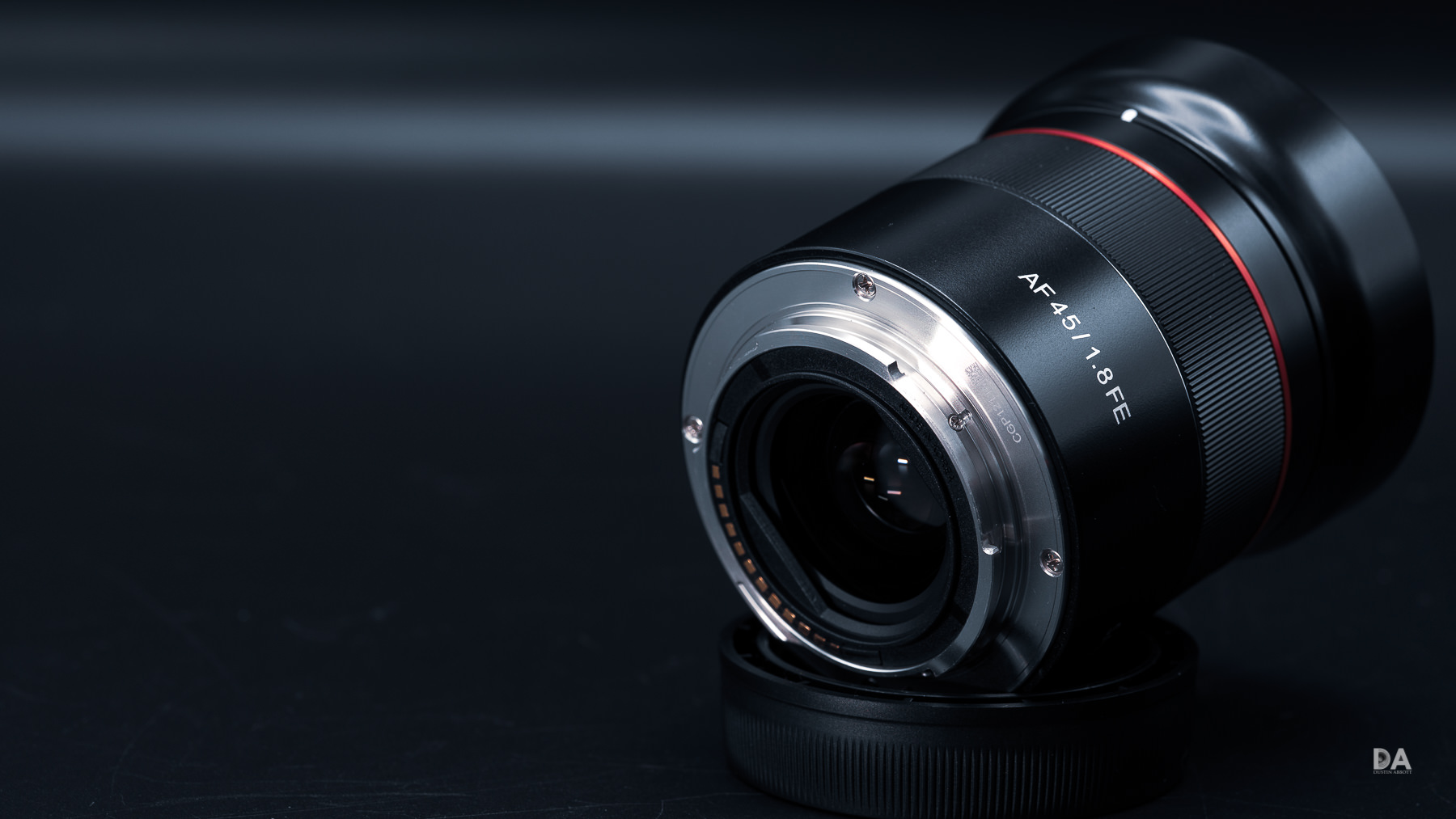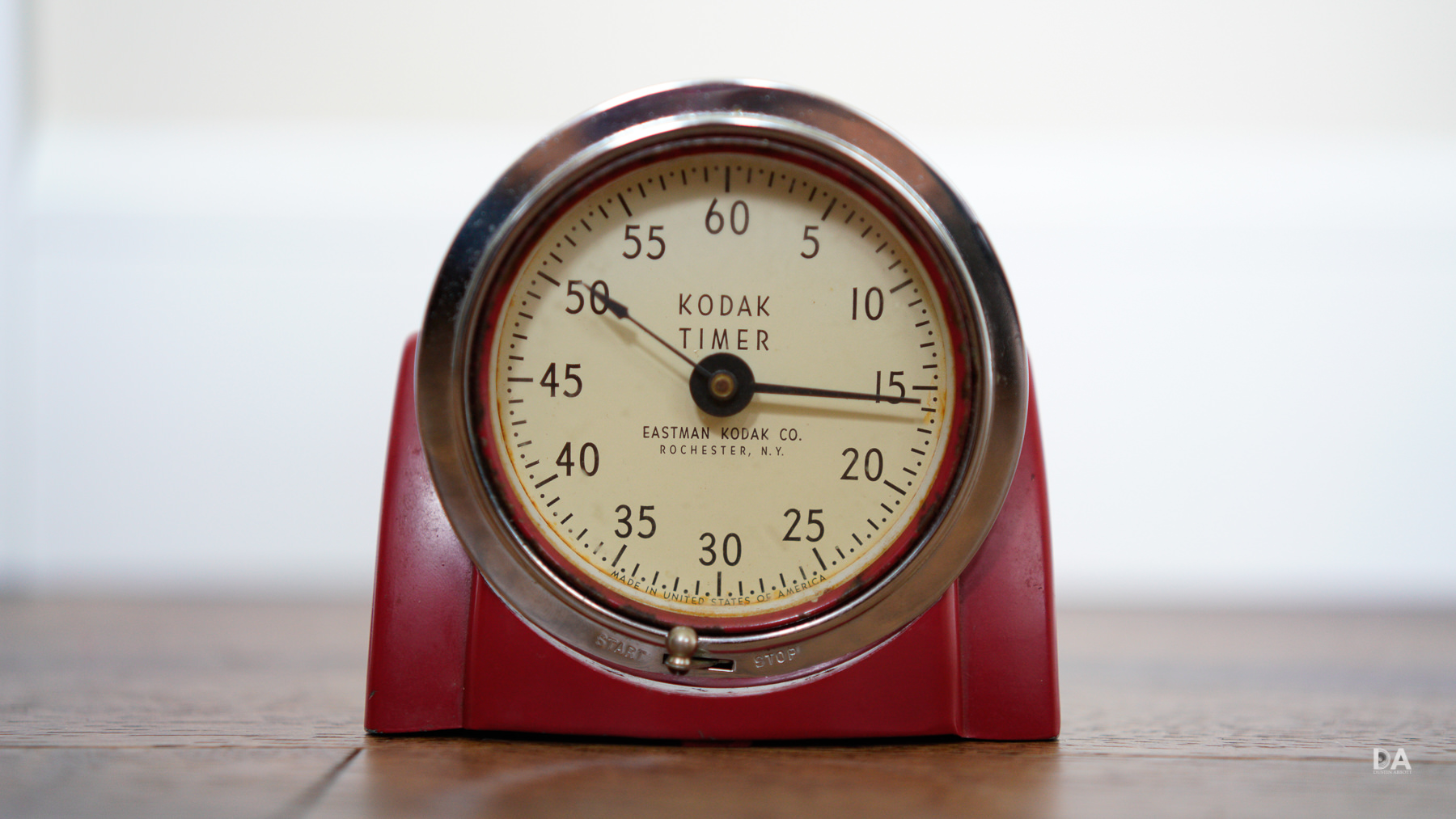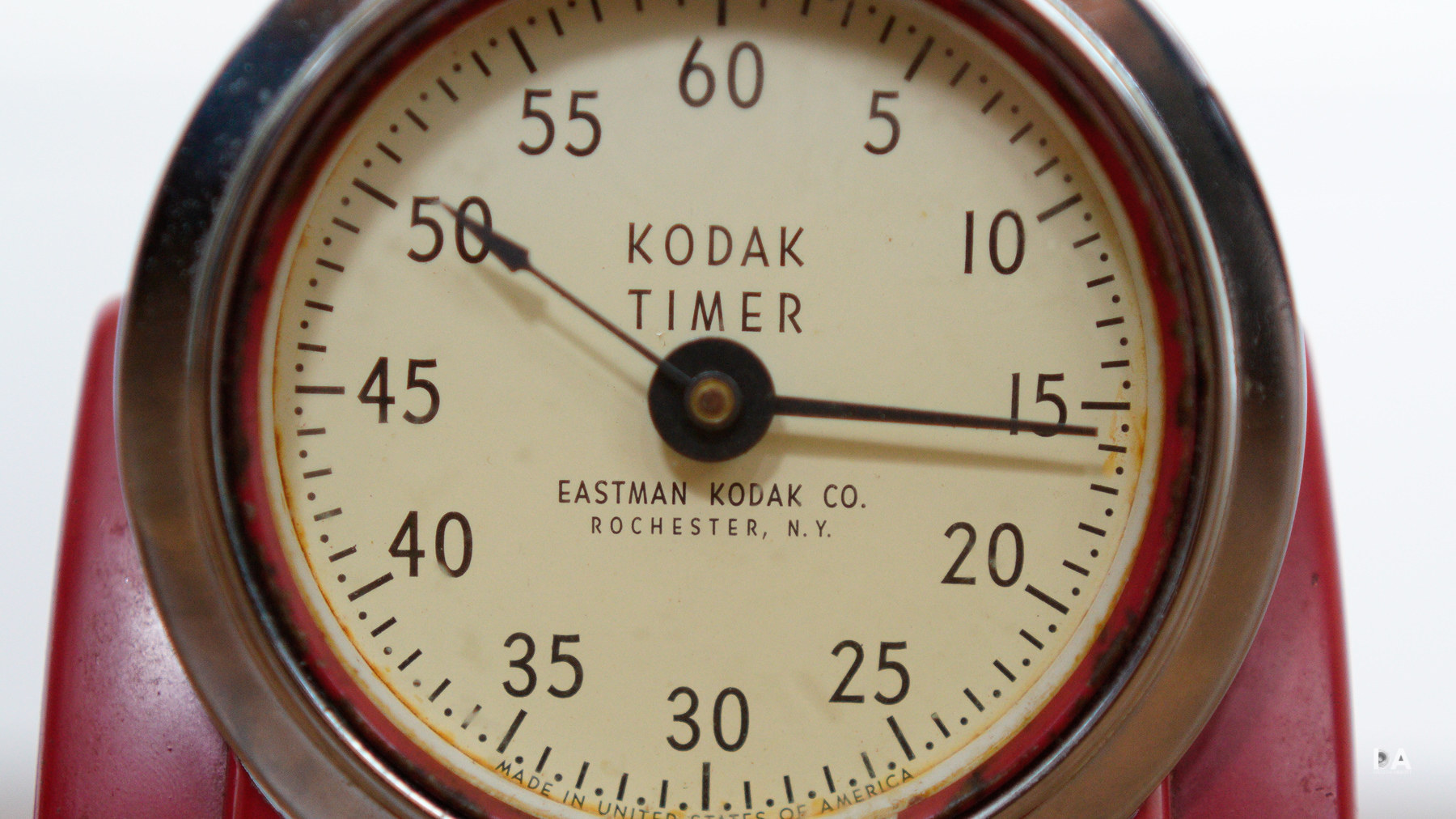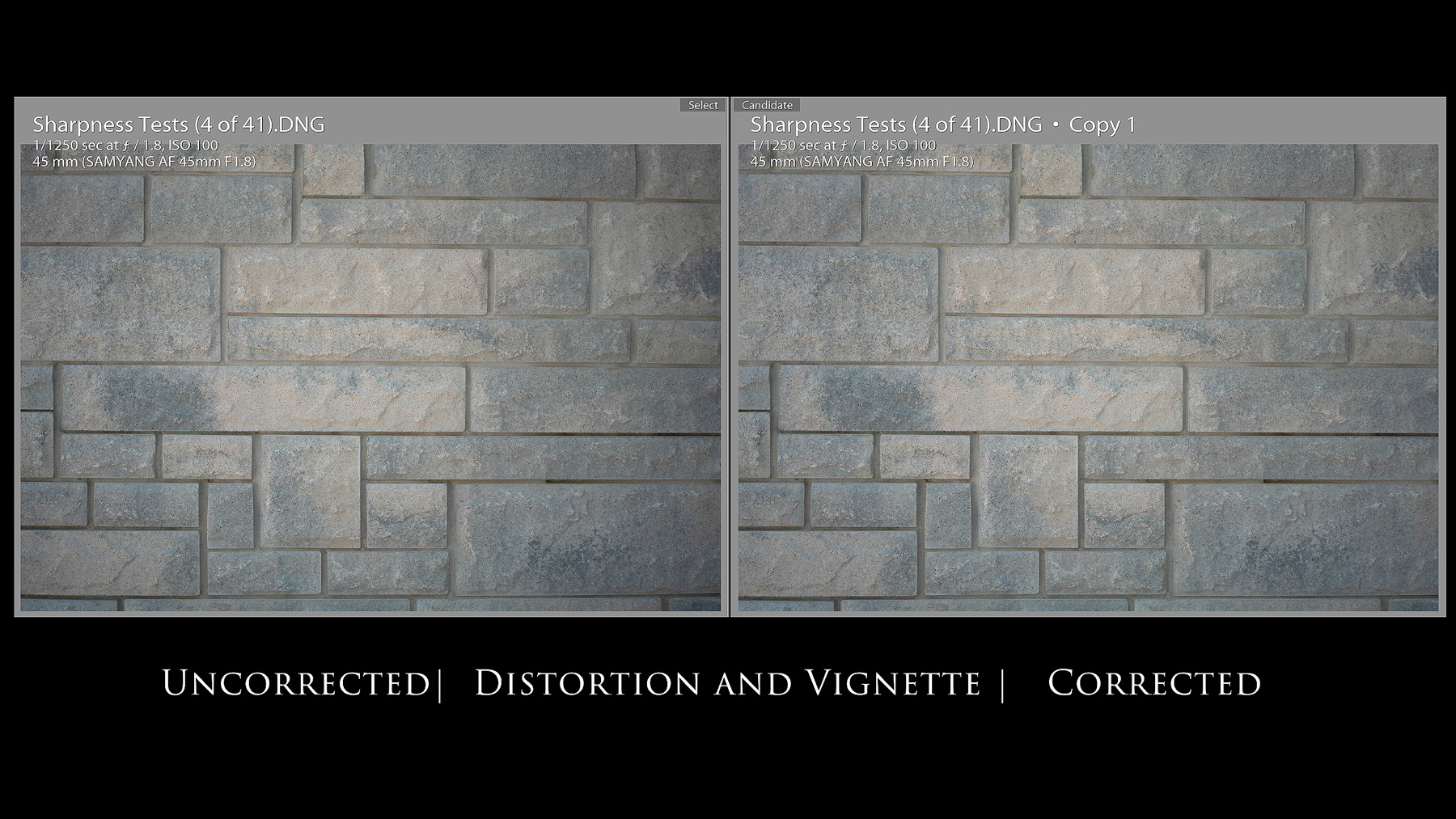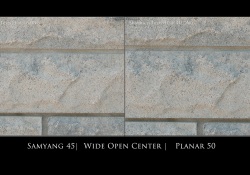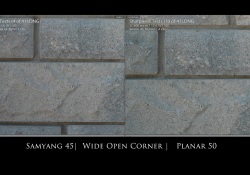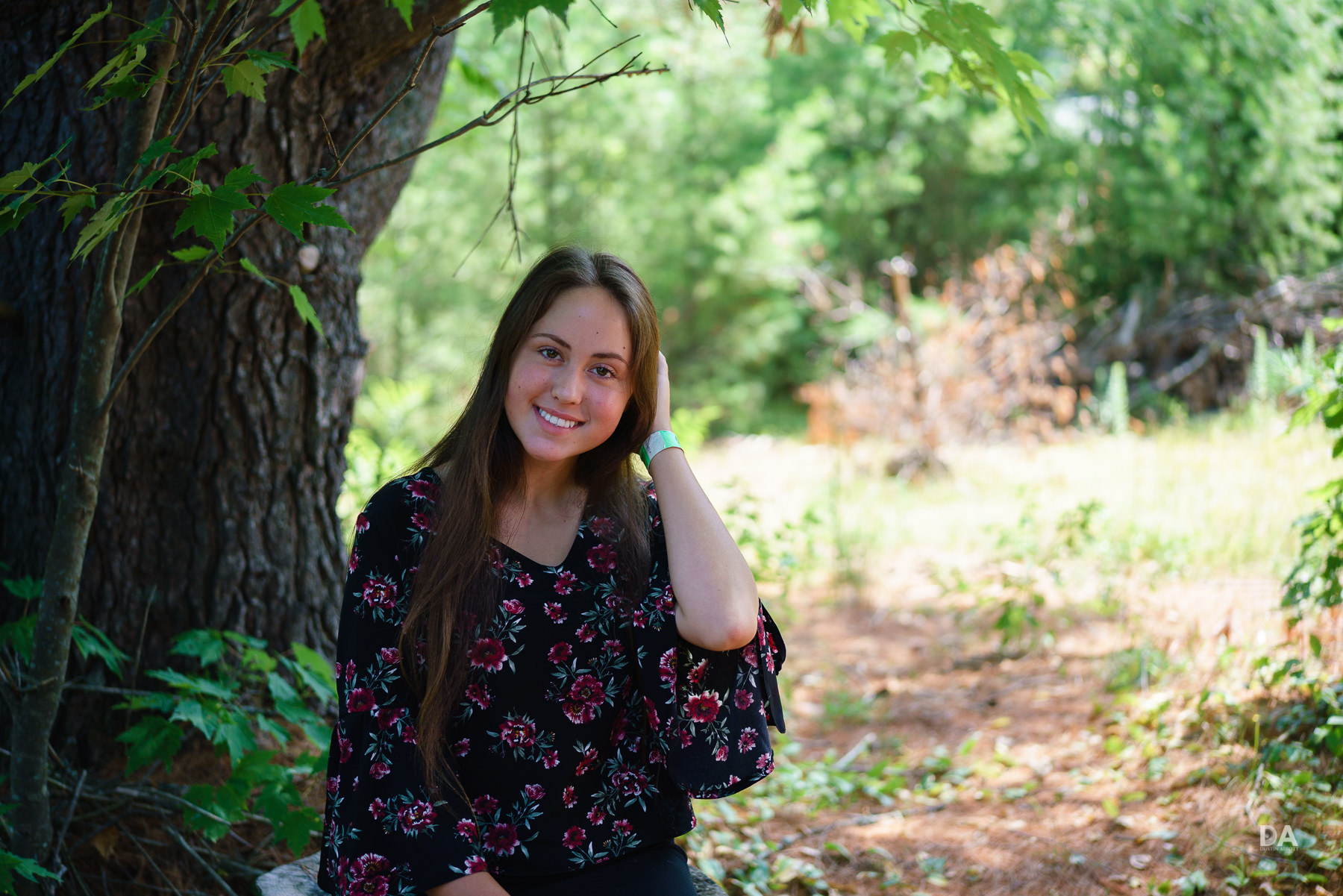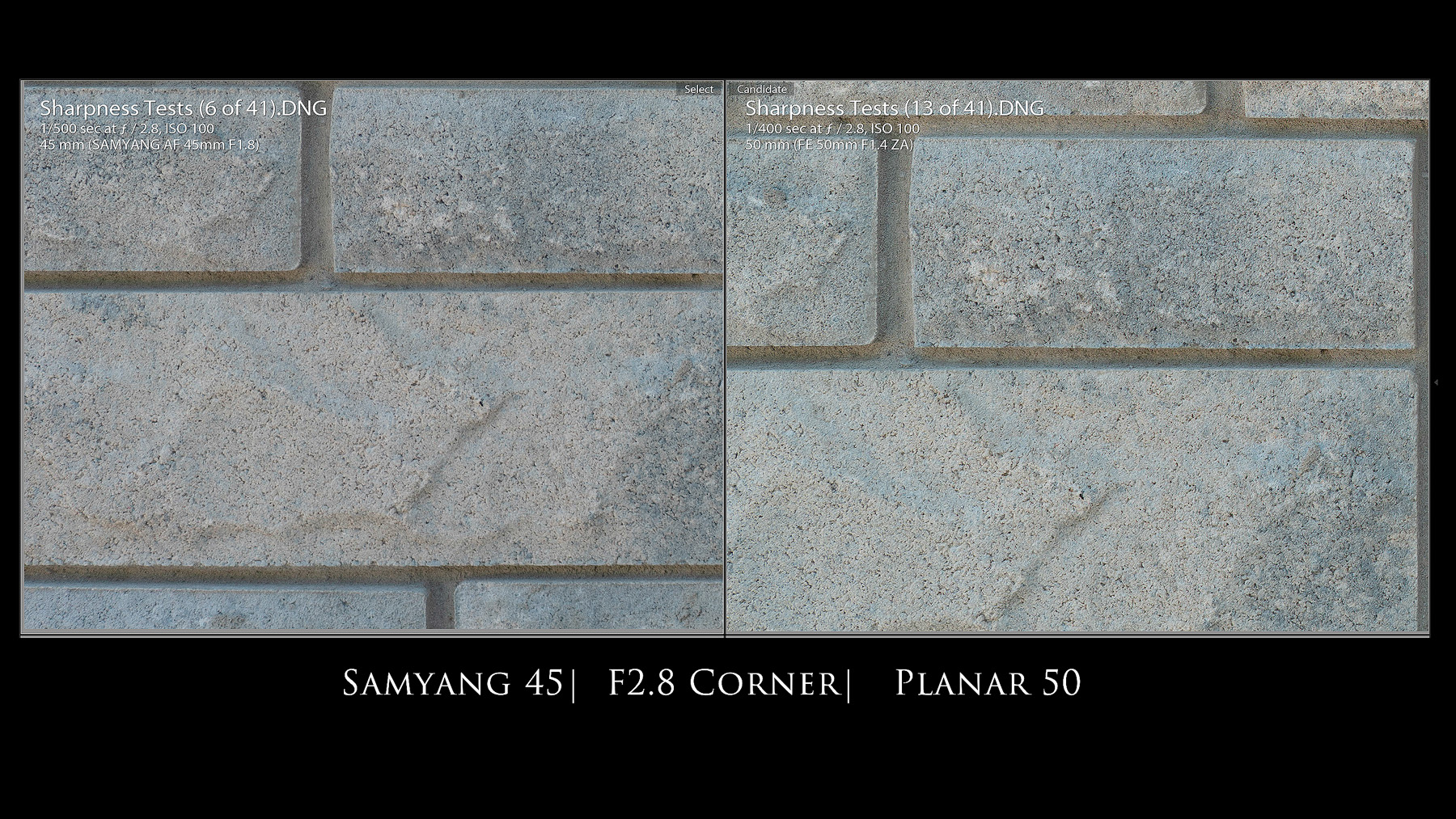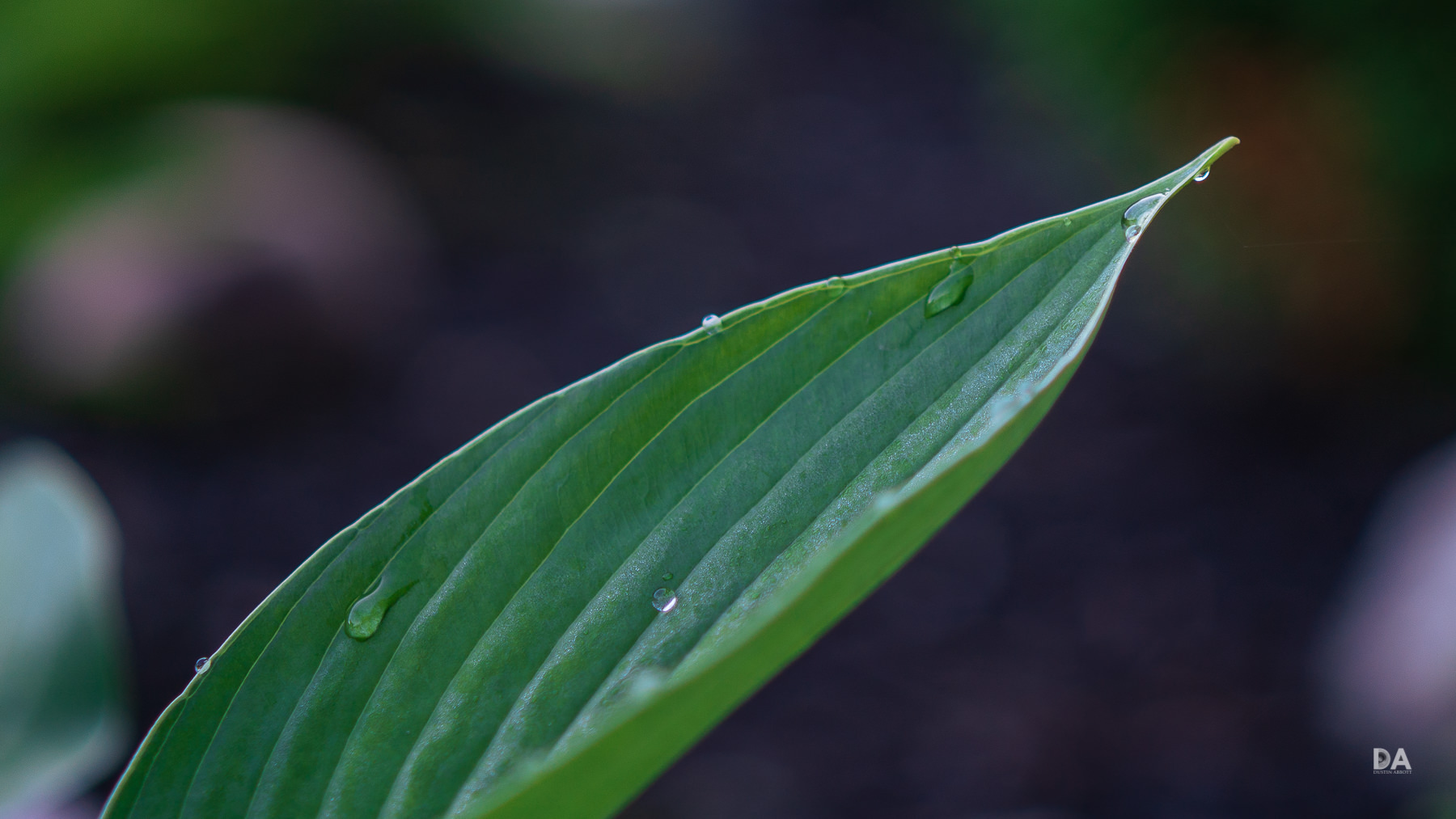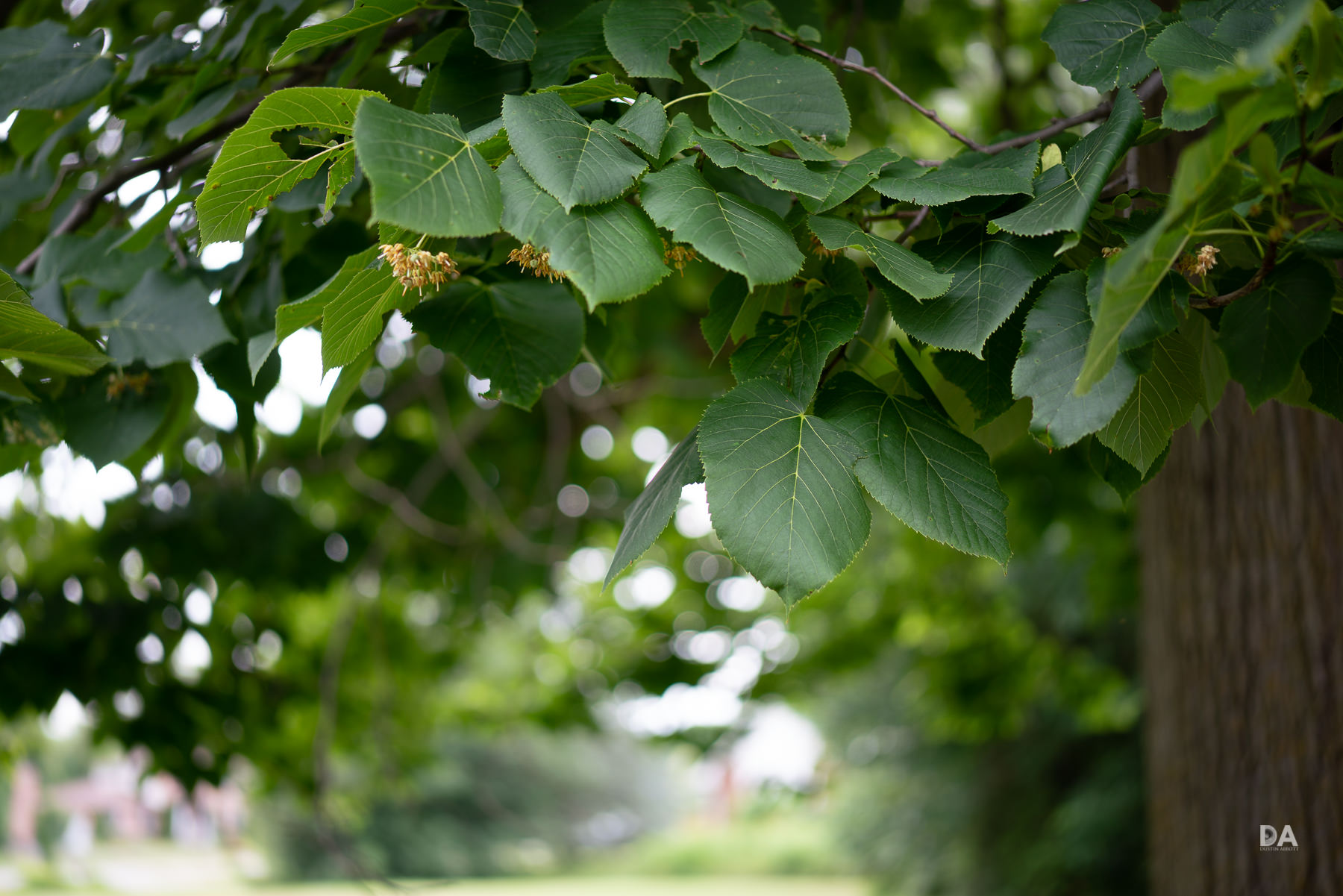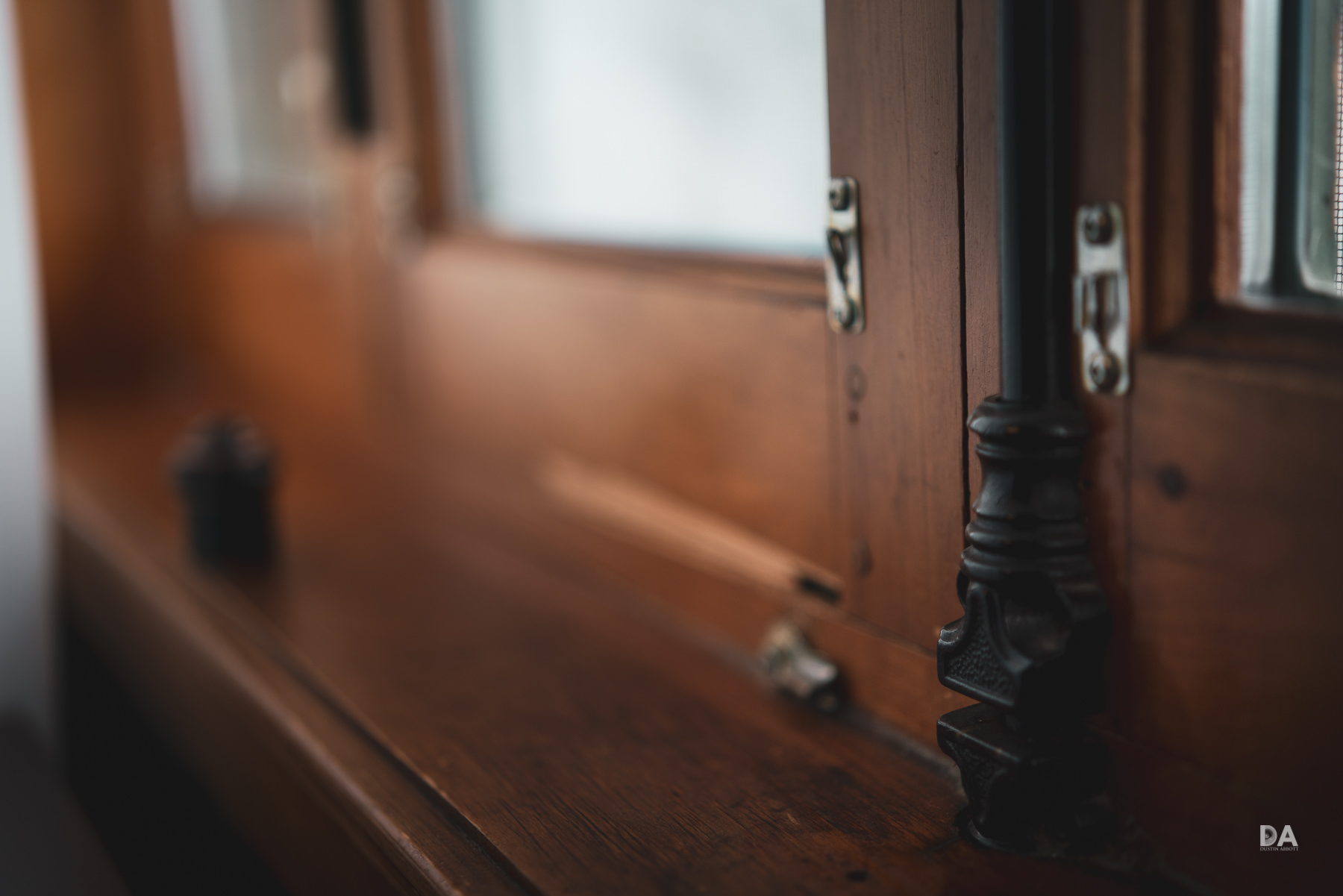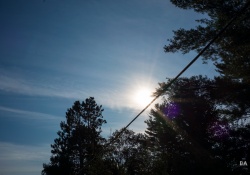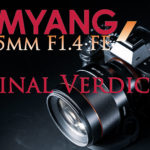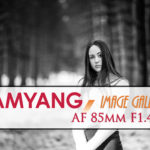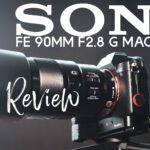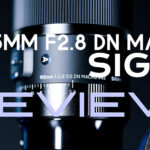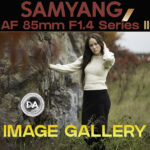It feels like Samyang AF has finally arrived…at least on the Sony FE platform! For decades Samyang was limited to producing manual focus only lenses, but a few years back they started to try their hands at the more complicated business of autofocus lenses. The first of these that I reviewed (Samyang AF 50mm F1.4) was a little rough around the edges, with a decidedly unrefined focus motor. Things got much better when I reviewed the 35mm F1.4 about a year later, and then really hit the stride with the release of the AF 85mm F1.4. Samyang has now gotten the autofocus thing figured out (at least on Sony), and their linear motor focus systems are now quick, quiet, and accurate. That remains true on their newest lens – the Samyang AF 45mm F1.8 FE (referred to as the AF45 throughout the rest of the review) – which combines a tiny size, light weight, and wonderfully “analog” optics in a reasonably priced ($399 USD) package.
Samyang has also shown an ongoing commitment to their lenses, with multiple firmware updates available for each lens to refine focus and solve glitches. On that note, however, Samyang lenses on Sony FE do not receive firmware updates through the camera (unfortunately!), which makes owning the Samyang Lens Station an important asset. It costs $60 USD, but it is worth having as it allows you to get the best out of your lenses. The Samyang Lens Manager software also allows you to make other tweaks to the lens behavior as well, including changing the speed of the manual focus ring. I will note one minor criticism, however, and that is that it has become fairly common for Samyang to need to roll out out one or two firmware updates within a month or so of each new lens release. I would like to see them do a little better job in beta testing lenses before release so that this isn’t necessary. Not everyone owns (or will own) the Lens Station, which means that there will be some users left with a negative impression of the lens performance because their lens is running the original firmware. I’m very thankful for the ability to receive firmware updates, and I appreciate that Samyang is diligent in releasing them, but I think the next step needs to be reducing the need for those firmware updates.
Samyang has previously released a couple of very compact autofocusing prime lenses for Sony, though with only moderately wide maximum apertures of F2.8. People loved the size of the lenses, but the autofocus systems were not always quite there. Fast forward to 2019 where Samyang has just hit a home run with the AF 85mm F1.4 (a truly excellent lens), and Samyang has gone back to the small and light formula for its most recent lens. The Samyang AF 45mm F1.8 is very light and compact (making it an intriguing option for those of you with an A6000 series camera, too, where it provides an equivalent 67.5mm focal length), but Samyang has added its recent progress with much more refined linear motor autofocus over the previous small, light options. I’m personally a fan of the 45mm focal length, and have reached for the Tamron SP 45mm F1.8 VC lens a lot in the past. The AF45 promises to be an easy lens to bring along, and will probably be a tempting option…if the performance measures up. Let’s explore that together…
Prefer to watch your reviews? Take a look at my definitive video review here:
Follow Me @ Patreon | My Newsletter | Instagram | Facebook | Twitter | Flickr | 500px
Samyang AF45 Build, Design, and Handling
Here are the bullet points from Samyang:
-
- Compact normal-length prime is designed for full-frame Sony E-mount mirrorless cameras, however can also be used with APS-C models where it provides a 67.5mm equivalent focal length.
- Bright f/1.8 maximum aperture suits working in difficult lighting conditions and also offers increased control over depth of field for isolating subjects and working with selective focus.
- One extra-low dispersion element reduces color fringing and chromatic aberrations in order to produce greater clarity and color rendering.
- Two aspherical elements control spherical aberrations and distortions for improved sharpness and resolution.
- An Ultra Multi-Coating has been applied to individual elements in order to reduce flare and ghosting for increased contrast and a neutral color balance.
- The integrated linear STM autofocus motor works in conjunction with Sony cameras’ focusing systems for quick, quiet, and precise AF control. Manual focus override is also available for refining your focus position.
- Internal focusing design maintains the overall lens length and prevents the front of the lens from rotating during use.
- Rounded nine-blade diaphragm contributes to a smooth and pleasing bokeh quality.
- Included lens hood helps to block stray light from causing flare and ghosting.
The AF45 is a wonderfully light and compact lens. It is 2.43 (D) x 2.21″ (L) / 61.8 x 56.1 mm and weighs only 5.71 oz / 162 g. This results in a front filter size of only 49mm, so filters will be cheap! I recommend that you watch this video episode to get a closer look!
Too many lens makers have lost sight of the fact that photographers operate in the real world where size and weight of their gear does matter. It is a breath of fresh air to handle lenses that consider the reality that photographers have to actually carry, handle, and transport lenses. It seems like the size of lenses has been ever-growing, and while I appreciate the optical performance of many such lenses, I also know the reality that when I’m packing my personal photography bag for a trip I tend to choose lenses that are reasonably sized. The AF45 is such an easy lens to bring along, and, as a result, it made the cut of getting into the bag more often than my typical review lens, which meant it got used about 35% more during my review period.
Despite the extremely light weight of the lens, the AF45 is nicely made. It is a mix of metals and engineered plastics, and has a look that is a cut above the typical consumer grade lens. Like other AF lenses for Sony from Samyang, there are no switches on the barrel, leaving it with a clean, black satin finish broken up only by the focus ring and a red accent ring. I really like the aesthetic of these lenses; they look great! I would prefer to have an AF/MF switch on the barrel, as I find using a switch to be faster and more intuitive than controlling this from within the body. Thus far, however, this has not been part of Samyang’s formula of Sony lens design.
The focus ring is finely ribbed for easy grip and moves nicely. It has good damping and feel, though the AF45, like most mirrorless lenses, is designed with a “focus-by-wire” manual focus system. With such lenses there is not direct coupling between the focus ring and internal focus elements. Instead input from the MF ring is registered and run through the focus motor itself, which then drives the elements forward or backward to achieve manual focus. Due to the nature of this focus system there is no “hard stops” at minimum or infinity…the ring can be moved endlessly with no limit on either end. The “feel” of these focus rings still varies widely, however, with some easier to use than others. On Sony, MF is aided by two things. First, when input is detected on the focus ring on the 35AF, the selected focus area will automatically be magnified in the viewfinder or LCD screen to help you visually confirm focus, and a digital distance scale will also be displayed to help you determine the distance to the subject. You can further augment this with focus overlays if desired. Samyang has refined the feel of the MF ring in their last couple of lenses, and I find manual focus on the AF45 to be a positive experience. Fortunately you will probably rarely need MF for stills, however, as the AF system works very well.
On the video front, however, just realize that no focus-by-wire lens is going to feel quite like a true MF lens. They rarely move in a true linear fashion, so the amount of focus change will vary depending on the speed of your input. The AF45 is better than many, however, and making major focus changes doesn’t require endless rotations.
The one thing missing from the formula this time around is weather sealing (which was present in the 85mm F1.4). I got caught out in a sudden squall with the AF45 mounted on my Sony a7RIII and just on a strap. I had nothing to cover the lens/camera with, so it got fairly wet. When I got out of the rain I discovered there was a bit of water between the lens and the mount on the camera (a gasket would have been nice!) The lens at that point gave an error code on the camera, but as soon as I cleaned the water off the contacts everything worked fine (and has continued to do so ever since). Still, avoiding inclement weather is wise when using a lens without weather sealing.
The AF45 features a nice aperture iris with nine rounded blades. It does a good job of retaining a circular shape even when stopped down.
One area where the AF45 does not resemble the Tamron 45mm F1.8 VC (unfortunately) is when it comes to minimum focus distance and maximum magnification. MFD is 1.48′ / 45 cm (compared to 11.42″ / 29 cm for the Tamron), which results in a MUCH lower 0.12x (vs 0.294x) magnification figure. The Tamron could do psuedo-macro things, and the Samyang most definitely cannot. On a positive note, however, the performance near MFD is pretty good even though the magnification isn’t great.
The Samyang AF45 comes with a very useful little hard case and an even smaller lens hood. Fortunately (as we will see below), a larger lens hood is not needed as the lens is naturally quite flare resistant. The little hood easily reverses for storage and everything fits nicely into the little hard case which provides good protection for traveling with the lens.
All in all, this is a nicely made little lens that is a joy to use. I really wish it had weather sealing, but it is also releasing at a price point where the absence is more forgivable. The size and shape of the lens reminds me of a Zeiss Loxia lens…and that’s a good thing.
Samyang AF45 Autofocus Performance
There’s no place that shows the progress that Samyang has made more than in the area of autofocus. Gone are the days where the focus motors felt primitive and unrefined. The linear motor focus system of the AF45 is snappy, quiet, and accurate.
The AF45 is as quiet as any lens that I’ve used, with little to hear but the focus confirmation lock. If you focus with the lens right next to your ear, you will hear a faint whirring, but it isn’t hardly audible even in a quiet environment. In AF-C mode autofocus is mostly near instant, with only a split second pause when making major focus changes. AF-S is only slightly longer, and any slowdown will be dependent on poor contrast or light. I had zero real-world issues with focus, however, and have a catalog of many well-focused results.
I found that the AF was able to track real-world action during tracking some runners going around the bases in softball or kids jumping into a pool. The end result was excellent, with good focus and detail in each of the frames.
Eye AF also worked exceptionally well. I had excellent results in a number of portrait scenarios at a variety of distances. As per usual, Eye AF works best at close to medium distances, and the Eye AF system in the camera struggles to resolve the eye at greater distances.
In video the AF did a good job, with quiet focus pulls and minimal settling or pulsing. There is some minor slowdown during big focus pulls as the lens approaches the target and assures proper end focus, though once it arrives at the destination it stays there. I’ve been using the AF45 for some of my video episodes, too, as it produces a really great looking image. Focus is mostly very steady during those static scenes, though I did have one episode with dramatically changing light and a lot of wind that resulted in some moments where focus shifted to other subjects if I looked away from the camera.
Autofocus is a positive point for the AF45, and that makes me really hopeful for future Samyang lenses, as it seems like they’ve now gotten autofocus on Sony platforms figured out.
Samyang AF45 Image Quality
I have to confess that my expectations weren’t particularly high for this lens. I saw from the release information that it wasn’t particularly expensive, very compact, and with a smaller maximum aperture than what had been the case with recent Samyang lenses. I saw one review from another reviewer that chart tested the lens and found that image quality in the center was good but with corner sharpness that wasn’t exceptional at wide apertures. But my time with the AF45 has been a reminder that there is far more to lens design than perfect correction of all aberrations. Far too often the pursuit of clinical perfection robs a lens of its character. That’s not the case with the AF45; it is a wonderful mix of modern sharpness and contrast but with an “analog” feel and character to its rendering. Put simply, I really like the look of images that come from this lens.
Want to see why? Check out my detailed image quality breakdown video episode:
The AF45 shows surprisingly low levels of vignette for such a small front element covering a full frame sensor. The total quantity of vignette is not bad (I used only a +23 value in Lightroom to correct it), though I did find that the vignette extended fairly far into the frame (I set the midpoint at 15). There’s also a very mild amount of barrel distortion (I corrected it with a +3 in the manual distortion slider). Here’s a look at the before and after:
For most shooters neither of these will be significant enough to impact much of anything. You get a surprising amount of vignette lift by F2 (only one-third stop down) and it mostly cleared by F2.8.
For my resolution comparisons, I used what is certainly an unfair point of comparison – the very expensive Sony Zeiss Planar 50mm F1.4. The Sony costs nearly 4x as much, but it was the most comparable lens in terms of focal length that I had on hand. The center of the frame is actually quite similar with both lenses wide open. The Planar has slightly higher levels of contrast, but not by much.
The great center sharpness is easy to see in real world shots; look at how fantastic the resolution and contrast is on the face of the puppy here at F1.8:
A slight stop down to F2 increases contrast a bit, and there’s a lot of detail in this F2 portrait:
Stopping down to F2.8 sharpens things up more, and both lenses look fantastic in the center at F2.8 (but with a slight edge in contrast and resolution going to the Planar):
If we look into the corner, however, we’ll find that the Planar has left the Samyang behind. It’s now essentially as sharp in the corner as it is in the center, while the AF45 looks clearly softer in the corner than in the center. It hasn’t taken the big leap in corner sharpness yet while the Planar has.
There’s some corner improvement at F4, a bit more at F5.6, and then a little more at F8. From F5.6 on corners will look nice and sharp for landscape images, though never as extremely good as the Planar in the corners:
There’s enough there to look good, but the acutance at infinity is not the highest that I’ve seen.
Where the Samyang shines is in the general look of the images. I showed one of these images to show a crop of the real world resolution, but let’s take at the general image:
The global look of the color, contrast, and detail is excellent.
Here’s one at just F2, but using the sweet spot of the lens:
There’s a lot of punch to that image. Here’s a night image at F1.8:
Contrast and dimensionality looks great. Here’s a interior shot at F2:
Looks great, doesn’t it? How about another simple available light of my son at F2:
That’s just out of camera, and yet there’s a nice feel to the image. It’s punchy and has good detail and contrast, but the combination of color, contrast, and detail feels very natural and appealing. That’s a certain amount of character that goes beyond raw resolution and contrast.
Chromatic aberrations are well controlled, but not perfectly controlled. You’ll see a little fringing (mostly in the shape of some green fringing in bokeh highlights).
I have long noted that often lenses without perfect correction of chromatic aberration have more character in their rendering than those that do. There’s a fine line between too much aberration, which becomes distracting and sometimes ugly, and no aberration, which can leave images looking somewhat flat and clinical. I personally think that Samyang has found the right balance here, as there isn’t enough CA to damage images and/or contrast, but just enough that the bokeh is softer and rendering is more appealing. Take a look here:
This is at F1.8, and there is plenty of detail on the subject (see the crop), but the background is particularly beautiful. It’s surprisingly soft and creamy for a lens that only has an F1.8 aperture and a relatively short focal length. I find the image itself very rich and beautiful, and it is in large part because of the way the lens handles color and contrast in the defocused areas. Here’s a few more images that show what I mean:
But the lens also has enough “punch” to produce good contrast at F1.8-2.
The bokeh doesn’t have perfect geometry. You will definitely see some “cat eye” effect along the edges of the frame.
In some situations almost take on a bit of “swirly” character of some of the vintage Helios lenses:
The bokeh is surprisingly creamy in the right situation, though, with a nicely blurred background:
If you prefer more consistently circular shapes, try stopping the lens down a bit. Here’s F2.8:
My point is that there is a lot of character there, and thus it creates images that I personally like. There’s a lot of the vintage charm that I love from of my legacy glass (rich color, unique bokeh rendering), but with the modern sensibilities of better correction and higher contrast (not to mention autofocus!!) Add a little post processing in there and even simple things become really interesting subjects:
As previously mentioned, the lens hood is really quite tiny, but I’ve had essentially no issue with flare during my period. Adding the sun into the frame just adds a little character.
In short, the AF45 is a lens that isn’t perfect but is perhaps all the better for it.
If you need pin-sharp corners, look elsewhere, but if you want a general purpose prime that creates beautiful images, the AF45 is likely to delight.
Conclusion
Full disclosure: I’m a fan of the 45mm focal length. It can do most all of the 50mm things almost as well as a 50mm lens but that extra little bit of width also allows it to do a lot of 35mm things. I love the focal length for “everyday” images: birthdays, events, and family time.
The Samyang AF 45mm F1.8 adds something else I like: a lens with character. It’s not sterile or clinical, but has an analog, vintage character that I find warm and welcoming. I recognize that this is a “taste” thing and more subjective than objective, so I welcome you to visit the image gallery and decide for yourself. What is objective, however, is the observation that this is a wonderfully small and compact lens that ably covers the full frame image circle. I personally would choose it over the Sony Zeiss 55mm F1.8 (a slightly larger but similar lens) for the simple reason that I like the feel of the images more (and also prefer the focal length). The Sony is a little sharper in the corners and probably more absolutely sharp stopped down, but the difference is not significant. What’s even more appealing, however, is that the AF45 is less than half the price of the 55mm. The two lenses have a similar focus performance (both are quiet and fast) and both lenses are wonderfully portable.
Though my initial expectations weren’t particularly high, the AF45 quickly became one of my favorite lenses that I’ve reviewed in recent history. I like the price, I like the size, and, most importantly, I like the images from the lens. This is one that will be staying in my bag!
Pros:
- Great size and weight
- Beautiful rendering that makes for special images
- Unique bokeh character
- Autofocus is fast and very quiet
- Good Eye AF and tracking performance
- Included case is very useful
- Excellent price
- Great color and contrast
Cons:
- No weather sealing
- Corners never get pin sharp
Purchase the Samyang AF 45mm F1.8 @ B&H Photo | Amazon | Amazon Canada | Amazon UK | Amazon Germany | Ebay
Purchase the Samyang Lens Station @ B&H Photo | Amazon | Amazon Canada | Amazon UK | Amazon Germany | Ebay
Sony a7R III Camera: B&H Photo | Amazon | Amazon.ca | Amazon UK | Ebay
Peak Design Slide Lite: Peak Design Store | B&H Photo | Amazon | Amazon Canada | Amazon UK
Sony a6500: B&H Photo | Amazon | Amazon.ca | Amazon UK | Ebay
Peak Design Leash Strap: Peak Design Store | B&H Photo | Amazon | Amazon Canada | Amazon UK
BenQ SW271 4K Photo Editing Monitor – B&H Photo | Amazon | Amazon.ca | Amazon UK
Adobe Photoshop Creative Cloud 1-Year Subscription
Alien Skin Exposure X4 (Use Code “dustinabbott” to get 10% anything and everything)
Visit Dustin’s Amazon Storefront and see his favorite gear

Purchasing your gear through B&H and these links helps fund this website and keeps the articles coming. You can also make a donation here if you would like. Visit my Amazon page for some of my gear of choice! Thank you for your support.
Great News! I can now offer a 5% discount on all purchases at Amplis Foto, Canada’s Leading Photographic Supplier. Please enter discount code: AMPLIS52018DA in your cart. It is good for everything in your cart, and is stackable with other coupons, too! It will take 5% off your entire order! Proceeds go towards keeping this site going and providing you with new reviews!
Check me out on: My Patreon | Sign Up for My Newsletter | Instagram | Facebook | Twitter | Flickr | 500px | Google+ |
Use Code “DUSTINHDR” to get $10 off ($15 CDN) any Skylum product: Luminar, Aurora, or AirMagic
Keywords: Samyang AF, Samyang AF 45mm, Samyang AF 45mm F1.8, 45mm 1.8, AF 45mm 1.8, Samyang 45 1.8, Samyang AF 45mm F1.8 FE, Sony, Samyang AF 45mm Review, Samyang AF, 45, 45mm, 45mm 1.8, 85 1.8, Dustin Abbott, AF 45mm Review, Portrait, Linear Motors, Sony a7RIII, Sony a7III, Eye AF, Bokeh, Sharpness, Resolution, Rokinon, Rokinon 45mm, Rokinon AF 45mm, AF 45mm F1.8, Video Test, Sample Images, Real World




